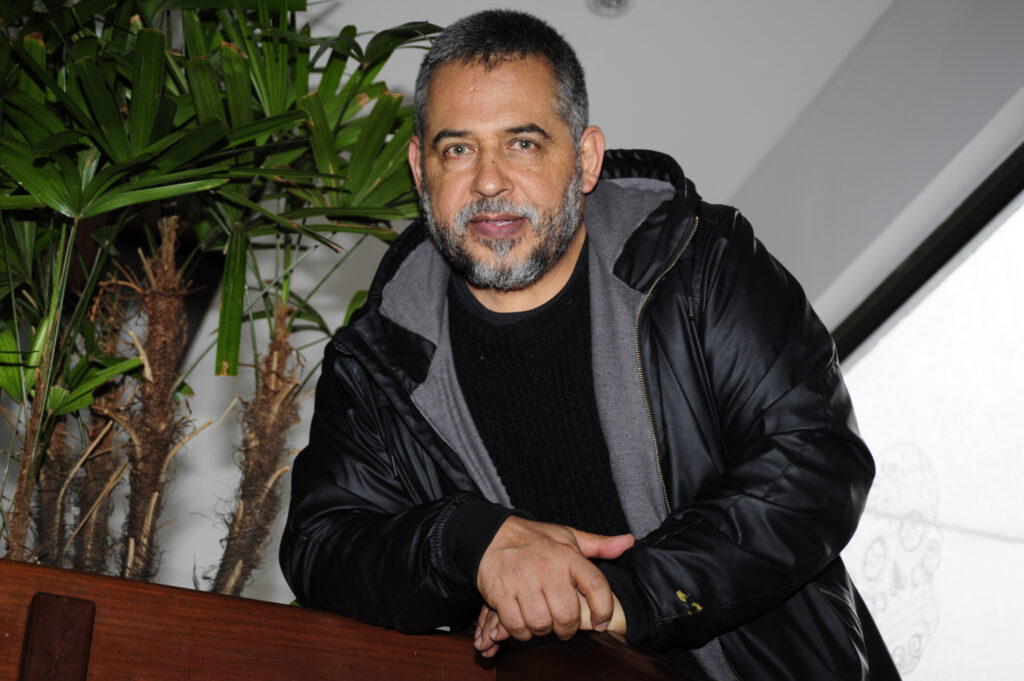The Colombian writer and journalist talks about gritty realism, literature, protests, and the pandemic.

“In the past Latin American writers went to Paris or London, it was an obligatory stamp to be a certified artist. That’s been flipped,” says Mario Mendoza, bearded and hoody-ed on the Zoom call, twisting his wrist. “Today, if you want to be truly contemporary, you go to Bangkok, Mexico City or Bogotá. The city of the future is a third world one, full of entropy, chaos and exuberance. We think that if we respect the traffic lights, if we behave ourselves, perhaps one day we will look like the Swiss. It’s the reverse. The Swiss are becoming more like us every day.”
Mendoza has been chronicling Bogotá, often from its seediest angles, in his crime novels and science fiction since the 1990s. Judging by the prominence of his books – photocopied and cling-film bound – on the knock-off book stands that line Avenida Séptima and Calle Jiménez, he can confidently lay claim to being the most pirated author in Colombia, with a cult status but no translations. In a country where Gabriel García Márquez’s shadow looms large, the literary visitor can be left flummoxed by Bogotá, a city as unwritten as it is unloved. Mendoza puts a grimy finger on the capital’s pulse.
“There’s no magical realism in my work, it’s not about exuberant, musical sentences,” he says. “For me, beauty isn’t to be found by looking up, but the contrary. You need to look towards the cloacas of the city, the underground, you have to face the darkness.” He compares his task to that of a war photographer, for whom the power of the image isn’t in the beauty of its subject, but in the ability to capture the revelatory instant in cruel and violent situations.
Mendoza recognized that Colombia lacked the sort of urban literature that had grown up in Mexico City and Buenos Aires over the course of the twentieth century. In 1994, at the age of thirty, he published La Ciudad de los Umbrales (City of Thresholds) about five university friends drenched in the lore of the city’s brothels, drug dens and cemeteries. His second novel, Scorpio City is a bleak police noir involving a serial killer, secret sects and the 1976 massacre of garbage recyclers, an act of urban cleansing by the police. His most famous novel, Satanas (2002), features demonic possession, scopolamine gangs and the 1986 mass shooting at the Pozetto restaurant.
This “trilogy of pure psychopathology” comes with significant first-hand experience. Hailing from a well-to-do neighbourhood in the north of the city, Mendoza spent most of his twenties in the roughest sectors of the south and he lived, for a period, with recyclers in the Cartucho neighbourhood. The Pozetto incident was even closer to home. Mendoza studied literature with the shooter, Campo Elias, a former US soldier who had written his thesis – chillingly – on Dr Jekyll and Mr Hyde. Perhaps unsurprisingly, optimism is in short supply.
“In the western world the detective restores order and justice is served. In the Latin American case there is no catharsis, there is no happy ending, just general chaos. If you put Sherlock Holmes in the centre of Bogotá he wouldn’t survive twenty four hours.” With his dark topics and nihilistic outlook, Mendoza has been a forerunner of a more recent trend towards gothic novels and horror stories in Latin American fiction. He believes that many writers in the region owe a debt to Edgar Alan Poe, especially in the translation of Julio Cortázar, the Argentine master of the short story.
“Poe was the virtuoso of the horror of the conscience, the horror of the industrial city, of the lost individual. I think nowadays in the midst of the pandemic, we are all a bit amnesiac, a bit catatonic, lacking life projects, depressed, don’t you think?”
“The vampire and the zombie are becoming daily characters. We’ve spent the last year and a half burying our friends and being incommunicado with the others. The pandemic has confirmed the central horror of Latin American gothic literature: the fear of the other. The other who is the enemy, who might spit on me, infect me, kill me for no reason.”
Dark secrets
The current situation has only exacerbated the resentments of a citizenry that has “never sat down on the couch, never done the necessary therapy.” Colombia, in Mendoza’s eyes, is a like a family harboring a dark secret which passes its trauma from generation to generation. The country’s failure to deal with inequality and a caste system of social classes that refuse to mix, is at the root of the problem. Walking south a few blocks along Avenida Caracas from Calle Jiménez, one comes to the former site of the Cartucho district, where the “recyclers live a nomadic life, making fire on the street corners and wandering around with machetes, a type of urban prehistory.”
A few blocks further and you reach the Las Cruces district, “Where an evangelical group is on their knees and a priest cures lepers and the possessed. You’re in the Middle Ages.” Meanwhile, the wealthy northern neighbourhoods suffer futuristic problems, “You can find hikikomori, people who only live in the virtual world, who don’t have sex, don’t speak, don’t have friends.” In Mendoza’s view, when one walks the city, you travel more in time than in space. “Bogotá is like an onion and peeling back the layers is at form of urban archaeology.”
His most recent work, this year’s Bitácora del Naufragio is a collection of stories that deals with the “pandemic within the pandemic”, that of isolation and mental health issues. He has been encouraged by the commitment of the youth-led protest movements in Colombia in 2019 and 2021 and focuses much of his non-literary efforts on promoting participatory democracy and promoting reading in the city’s southern neighbourhoods.
“We need to capitalize on the rage of the new generations and convert them into votes at the ballot box,” he says. “When I meet with the kids in the south, I tell them that a library is a very powerful weapon. They [the political class] don’t fear us because we are violent, they fear us because we are intelligent.”





